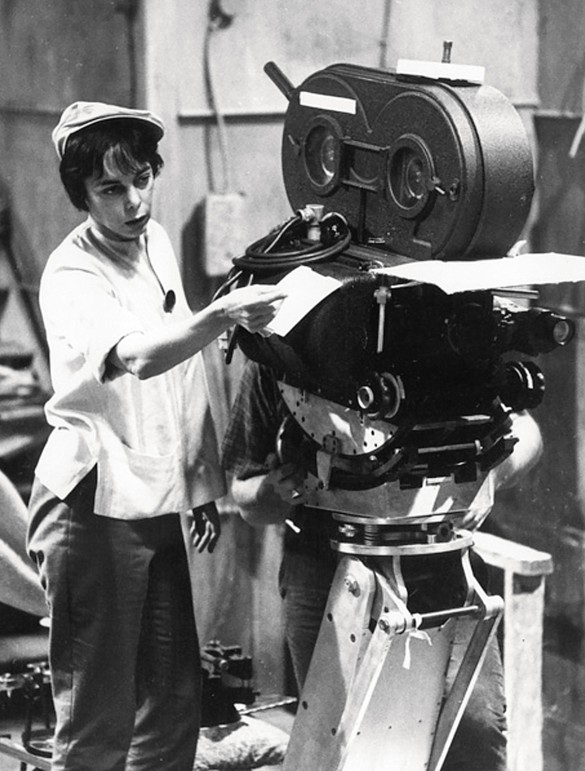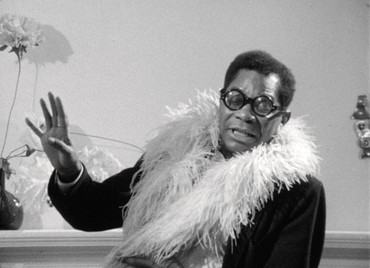
Rennie McDougall is a writer based in Brooklyn. His work has appeared in the Brooklyn Rail, frieze.com, Guernica, T Magazine, the Village Voice, and other publications. He received an Anthony Burgess Prize for Arts Journalism in 2018. His first book will be published by Abrams Press in 2025.
Like all periods of American cinema, the New Hollywood era of the 1960s and ’70s, a movement away from the major studios and toward independent filmmakers, was dominated by men. But Shirley Clarke, a New York filmmaker whose work preceded and inspired many of the New Hollywood directors, understood being a woman as an advantage as well as a hindrance: “It allowed me to do things that might not have gotten attention except that I was one of the few women who made films,” she said in an interview for Afterimage magazine in 1983. “I always knew it would be advantageous until I reached a very strange line. Everything was fine so long as I was not really going to take over.” As she did with many things, Clarke saw both perspectives.
The directors of the New Hollywood era, or the American New Wave, favored intimate filmmaking. They were inspired by the cinema verité style of the French, whose films strove for realism in dialogue, setting, and acting. Because of this fascination with cinematic “truth,” verité films often revealed the processes of filmmaking as a part of their realism, confessing to their audiences that there could be no true realism in film without acknowledging its element of fabrication.
Clarke was similarly obsessed with the dubious line between truth and fiction in film. She cofounded the Filmmakers Cooperative, a group that helped usher in a generation of independent filmmakers by raising funds for film distribution in New York. She made four feature films in the 1960s, one of them a 1963 documentary about the poet Robert Frost that won the Academy Award for Best Documentary Feature. It is her other three films of that decade, though—The Connection (1961), The Cool World (1964), and Portrait of Jason (1967)—that most keenly display the unique clarity of perspective in both her craft and her politics. Restorations of these works by Milestone Films have permitted new audiences to experience Clarke’s brilliant studies in the nature of truth (most of which can now be viewed on the Criterion Channel), and their cultural impact resonates just as strongly six decades later.
Clarke, whom the critic Richard Brody called “one of the prime inventors of creative cinematic nonfiction,” began making films in the 1950s with a 16mm camera that her husband, Bert Clarke, gifted her as a wedding present. Her early films such as Bridges-Go-Round 1 and 2 (1958) were like experiments with the camera, exploring colorization, overlapping composition, and movement. She also made short dance films (she had begun her artistic career as a dancer, training with Martha Graham), featuring the choreography of her peers Anna Sokolow and Daniel Nagrin.
In the short film Dance in the Sun (1953), for example, Nagrin prepares on a bare stage, warming up by using a piano as a ballet barre, removing his shirt, and preparing to perform for the empty auditorium. Intercutting Nagrin’s performance on stage with views of him dancing on a vast beach, Clarke juxtaposes the unadorned reality of the stage with what seems to be the scene he imagines as he dances. In another dance film, Bullfight (1955), still images of bullfighters in a dance with their bulls transition into shots of Sokolow, her hair pulled back into a tight bun, performing against a blank backdrop. Her movements recall the gestures of a matador, and Clarke cuts between the formally framed dancer and footage of crowds watching a bullfight. Clarke’s filmmaking sensibilities were seeded in these dance films; a person dancing for the camera is at once stylized and authentic, in a state of elevated performativity and grounded in the simplicity of their gestures, the limitations of their body in time and space, and the imagined space they conjure through their dance.
The Connection, Clarke’s first full-length film, was also her first to engage directly with race, the theme that would dominate her work. It features a group of Black jazz musicians waiting in a dilapidated loft for their dealer, played by Clarke’s creative and romantic partner Carl Lee, while a director and a cameraman film them for a documentary. Adapted from a play of the same name by Jack Gelber, The Connection allowed Clarke to fictionalize her own process, with an actor playing the part of a filmmaker directing his subjects. “There is something dirty about just peeking into people’s lives,” this director (William Redfield) says. The camera also acts not as a one-way mirror between actors and audience but as a window. “What do you want to hear?” one of the junkies asks the camera directly. “That we’re a petty, miserable, self-annihilating microcosm? That’s what you want to hear.”
Both The Connection and The Cool World—which presents frank depictions of police brutality against the Black community in Harlem—show Clarke’s interest in making the audience complicit with film’s power to blur truth and fiction, and in showing how that blurring is intimately linked with prejudice and racially motivated perceptions. Clarke was outspoken in her belief that racial inequality was America’s (and the world’s) most pressing social issue. She felt conflicted about the fact that her films, which she hoped could change minds and inspire advocacy, only reached a small, already converted avant-garde. She insisted that her political ideals required a disregard for the kind of rote forms of cinema that might have encouraged wider viewership; it was also simply her preferred artistic sensibility. In the documentary Rome Is Burning (1970), in which Clarke is interviewed about her films, she says, “I’m sort of afraid, I think, of being superficial, of dealing in broad clichés with something. In order to avoid that, I tend to look obliquely at it.”
Her last film of the ’60s, Portrait of Jason, filmed on a single night at Manhattan’s Chelsea Hotel, is her masterpiece. It begins with a Black man in Coke-bottle glasses staring directly into the camera, and through it at the audience. He introduces himself as Jason Holliday, repeats the introduction with a more playful tone in his voice, then introduces himself a third time as Aaron Payne. This is because he changed his name in San Francisco “to suit my personality”: “Jason Holliday was created in San Francisco, and San Francisco is a place to be created.”
One of the many things that make this documentary remarkable is that it may be the first film to feature a gay Black man at its center. More than that, it allows him to present himself on his own terms. Holliday is a performer, or aspires to be one; his long-held ambition to start his own nightclub act remains a pipe dream, despite the willingness of friends to fund him. Like Clarke, Jason encourages a playful relationship between truth and fiction. As he launches into each monologue for Clarke’s camera (stories Clarke said she’d heard Holliday perform “a hundred times before”), he stands up from a lounge chair, glass of Scotch in hand, as if taking his place on a comedy-club stage. After the elaborate choreography of the camera in The Connection and The Cool World, which Clarke referred to as a “ballet” between actors and camera, she wanted to free herself to focus on the dance of a human mind. A single camera frames Holliday, zooming into close-up, then zooming out to capture his fully embodied articulations. Clarke said the camera choices were led by her attuning to Holliday’s rhythms, “breathing with him.” He tells rambling and circular stories about his time at Rikers Island and about working as a housemaid for uptown white people. He performs impersonations of Mae West and Katharine Hepburn. His drunken turns of phrase are part ironic genius, part verbal blunder: “I have suffered expensively . . . I mean, extensively,” or “I’ve been in love once, many times.”
The film unfolds this way for nearly ninety minutes, meandering and repetitive yet never less than captivating. Then Clarke and Lee, who assisted Clarke behind the camera, turn on Holliday, accusing him of falsehood and bullying him to be honest. Holliday’s response becomes increasingly compelling. Initially, he resists; then he begins to cry dramatically, as if broken. Then, when Lee again demands that he quit acting and tell the truth, the tears suddenly stop and Holliday looks at Clarke, and at the audience, through the camera, radiating defiance. For Holliday, performance is a weapon against those who perceive him as the other, and who feel that the truth of him must meet their perception. At the film’s end, he says, “Nobody’s business now but my own. Nothing more to say.” A perfect beat to end on, yet Clarke leaves the camera rolling as Holliday performs one more about-face, resistance turning again to happy collaboration. “Oh, that was beautiful,” he says as the camera loses focus. “I’m happy about the whole thing.”
Many critics have asked whether Clarke exploited Jason in the film, but the question only scratches the surface of the work’s dynamics. Clarke presents a dilemma that perfectly reveals the triangle of forces present in documentary film: the subject, with their agency; the documenter, with their agenda; and the audience, with their perception, between those other two potentially warring interests. The immediacy of the film—Holliday’s direct address of the camera, the one-night shoot, Clarke’s voice from behind the camera, the “breathing” rhythm—all enhance the sense that these foundational dynamics between director and subject and audience are living, open questions that all three parties are puzzling out in real time.
As with dance, Clarke’s films have a liveness to them, a sense that the world of the film and that of the audience are momentarily bridged and exist together.
“I started that evening with hatred,” Clarke said of shooting the film, having known Holliday for years and grown tired of his theatrics. “There was a part of me that was out to do him in, get back at him, kill him. But as the evening progressed I went through a change, of not wanting to kill him but wanting him to be wonderful.” Clarke also said that the ending was premeditated. “I had every intention of a climax of something taking place,” she said. “I knew that I would have to get Jason to face the truth at some point. But I wasn’t positive how.”
Clarke never thought of the film as exploiting Jason in such simple terms, however. “I will not allow people to exploit themselves if they don’t win in the end,” she said. Comparing the film’s moral gray area to the Maysles Brothers documentary Grey Gardens (1975), Clarke says of both films’ subjects, “Of course they are willing victims. They want to be stars! Everybody does. People want to be in the movies. They don’t care. They will totally exploit themselves. The moral issue for the filmmaker, therefore, becomes an interesting one.” Holliday himself, when interviewed for the Village Voice in 1967, said, “I felt I’d be put down by squares and nowhere-type people. That upset me for a few seconds. Then I said, well, fuck them anyway. I know I am a great actor and I got a chance to prove it. I am ready to take anything that comes.” On the question of the truthfulness of his depiction, Holliday said, “It’s mostly truth.”
Over fifty years later, Clarke’s films (and Portrait of Jason in particular) cannot be viewed as mere period pieces. They are attempts at finding, through film, a present made permanent. As with dance, Clarke’s films have a liveness to them, a sense that the world of the film and that of the audience are momentarily bridged and exist together, are speaking to each other. In 1970, Clarke saw this potential in film as the medium’s hopeful future. “The dream-world film days, for the most part, are over,” she said. “Now the audience is being asked to participate.” As film today has most certainly recessed back to the embrace of dream worlds, Clarke’s vision of what cinema can do and be feels more vital than ever.
Photos: courtesy Milestone Films and the Shirley Clarke Estate















